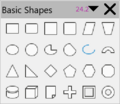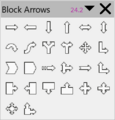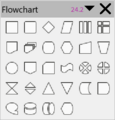Drawing Basic Shapes in Draw
TDF LibreOffice Document Liberation Project Community Blogs Weblate Nextcloud Redmine Ask LibreOffice Donate
Foreword
This Wiki page contains more information about the video.
Source for this description is the manual "Draw Guide".
The German terms "Grundformen" and "Standardformen" are both analogous to "Basic Shapes".
Link to the videos
Link to the video (in German [DE]):
Zeichnen von Standardformen V6.4.
Link to the video (in German [DE]):
Zeichnen von Grundformen V5.2.
Introduction
You can create 2D and 3D objects in Draw.
This chapter shows you how to draw 2D objects.
The following describes how to work with such objects.
"Drawing" Toolbar
There you will find most drawing tools.
This toolbar is usually at the left edge of the workspace.
If it is not visible, you can activate it by selecting ▸ ▸ from the menu.
The Handle is only visible when the "Drawing" toolbar is docked and unlocked.

| 1 Select | 2 Line Colour | 3 Fill Colour | 4 Insert Line |
| 5 Rectangle | 6 Ellipse | 7 Lines and Arrows | 8 Curves and Polygons |
| 9 Connectors | 10 Basic Shapes | 11 Symbol Shapes | 12 Block Arrows |
| 13 Flowchart | 14 Callout Shapes | 15 Stars and Banners | 16 3D Objects |
Statusbar
If the statusbar is not visible, choose ▸ from the menu.

When you draw a shape or add text, look for the information fields in the "Statusbar".
All changes to objects are displayed there at the same time.
Setting the drawing scale

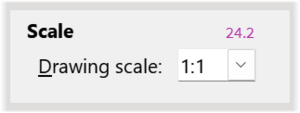
Depending on what you want to draw, it may be useful to preset the Drawing scale for the desired use before starting.
You can specify the Drawing scale in the menu via ▸ ▸ ▸ at Scale.
Or you select the Drawing scale in the Statusbar at Scale with a rightclick.
Switch on Grid
Go to the menu ▸ ▸ ▸ to adjust the spacing (Resolution) of the grid points.
These settings help you to quickly find the start and end points when drawing.
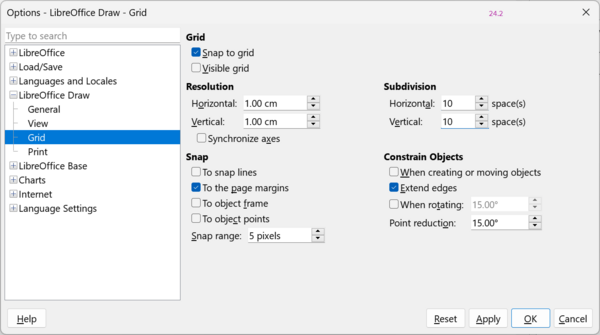
Drawing Basic Shapes
This Basic Shapes are available for drawing.
There are the tools that are already available on the "Drawing" toolbar light blue framed, for example "Rectangle", "Ellipse" and so on.
The tools that are not available on the "Drawing" toolbar, do not have this light blue frame, for example "Freehand line", "Edit points" and so on.
Selection of Basic Shapes
One-click selection
If you click the icon of a Basic Shape, you can draw the Basic Shape ( click-hold-drag-loose ).
After that, the cursor is back in selection mode.
Doubleclick selection
If you doubleclick on the of a Basic Shape icon, you can draw the Basic Shape as often as you like.
After then press the ESC-key.
Straight lines

On the Drawing toolbar, click the Symbol Insert Line ![]() and position the cursor where you want the line to start.
and position the cursor where you want the line to start.
Click-hold-drag the cursor.
Release the mouse button at the point where you want to end the line.
At each end of the line, a selection point is displayed, which is the identifier that this object is currently selected.
The starting point of the line is slightly larger than the end point.
You can draw the line at any angle.
If you press the ⇧ Shift-key while drawing a line, it will be drawn in one of 45° increments (0, 45, 90, 135, etc.) depending on the direction of drawing.
Hold down the Alt-key while drawing a line, the line now extends symmetrically in both directions from the starting point as you drag.
So you can draw lines from the middle of the starting point.
When a line is drawn, the default attributes are set.
To change any of these attributes, highlight the line where you click it.
In the Sidebar at "Properties>Line" the properties for the "Line" and their "Position and Size" can now be changed.
Or better, you use the assigned style in the Sidebar at "Styles" or create a new style in which you can the Properties change.
Alternatively, you can click ▸ in the menu or rightclick on the line and select from the shortcut menu to open the "Line" dialog to change line properties, line points, or corner and line end style.
Arrows
Arrows are drawn like lines, as Draw classifies the arrows as - Subgroup of Lines - that is, Lines with Arrowheads.
Click the "Lines and Arrows" icon to draw an arrow.
Release the mouse button when you have the desired length and direction.
Different types of lines and arrows
Click on the small arrow next to the right of the "Lines and Arrows" icon on the "Drawing" toolbar to open an icon selection in the Dropdown menu for drawing lines and arrows.
Select an arrow symbol from the "Lines and Arrows" Dropdown Menu and draw an arrow.
You can also change the arrow style after drawing.
In the "Line-Arrow Properties" Sidebar you can click on the "Line Start" and "Line End" selection and the "Arrow-Options" select.
The start options are on the left side (left arrow direction) and the end options are on the right side.
-
"Lines and Arrows" sidebar
-
"Properties Lines and Arrows" sidebar
-
"Properties Arrows" sidebar
Squares and rectangles
Drawing a square or rectangle is similar to drawing a line.
Squares
Squares have sides of equal length.
Click on the small arrow next to the ″Basic Shapes″ symbol and select the "Square" symbol.
Click and hold a square away from the starting point.
The mouse pointer is at the lower right corner when the square is drawn.
When the square is selected, you can use the tools of the Sidebar "Square-Properties" change the attributes for "Character", "Paragraph", "Area", "Shadow", "Line" and "Position and Size".
If you hold down the ⇧ Shift-key while drawing, you can draw a rectangle of any shape.
Rectangles
Rectangles each have a pair of edge lines that are unequal to the other pair.
Click and hold a rectangle away from the starting point.
When the Rectangle is selected, you can use the tools of the Sitebar "Rectangle-Properties" change the attributes for "Character", "Paragraph", "Area", "Shadow", "Line" and "Position and Size".
If you hold down the ⇧ Shift-key while drawing, you can draw a square of any shape.
Circles and ellipses
To draw a Circle or Ellipse (also called an Oval), you need the "Circle" or "Ellipse" symbol.
Circles
For a circle, both axes are the same length.
Click on the small arrow next to the "Standardformen" icon and select the "Circle" icon.
Draw the circle.
When the circle is selected, you can use the attributes in the Sitebar "Circle-Properties" with the tools change "Character", "Paragraph", "Area", "Shadow", "Line" and "Position and Size".
Ellipses
For an ellipse, both axes are unequal in length.
To draw an ellipse, click on the "Ellipse" icon.
Draw an ellipse.
When the ellipse is selected, you can use the attributes in the Sitebar "Ellipse-Properties" with the tools change "Character", "Paragraph", "Area", "Shadow", "Line" and "Position and Size".
The clicked icon is automatically drawn as an object in the middle of the workspace with default values.
The object attributes can then be changed via the "Properties" sidebar.
Adding Icons to the Drawing Toolbar

You can use the Drawing toolbar to more symbols add.
To do this you need to customize the "Drawing" toolbar.
Choose ▸ ▸ from the menu, or rightclick on the "Drawing" toolbar's Handle and choose to "Customise" Dialog to open.
In the dialog under "Toolbar contents", "Commands" further symbols can now be selected.
The symbols that don’t yet have a check mark can be additionally selected for the toolbar by setting the check mark.
If you don’t need symbols at all, you can also remove the check mark there.
If the desired symbols are marked with check marks, this can be confirmed with .
To reset the Drawing toolbar to its default settings, open the Customize dialog, click and .
Circle segment and Ellipse arc
To draw an arc or segment, click on the small arrow next to the "Basic Shapes" icon in the Drawing toolbar and select the desired tool.
Click-hold and drag the cursor at the start position to select a Leading Circuit to be created.
Release the mouse button.
Move the cursor to the point in the management circle where the segment is to be started.
The status bar displays the angle in degrees.
Click this point on the guide circle to draw the arc or segment.
To do this, move the cursor around the arc or segment.
The status bar displays the angle in degrees.
When you are satisfied with the arc or segment, click again to complete the arc or segment.
Curves, Polygons and Freehand lines
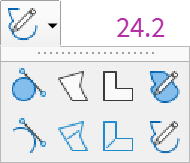
To draw a curve or polygon, click on the small arrow ![]() next to the "Curves and Polygons" icon in the "Drawing" toolbar.
next to the "Curves and Polygons" icon in the "Drawing" toolbar.
If you move the cursor over one of the symbols, a tooltip will be displayed.
Curves
Click and hold the left mouse button to create the starting point of your curve, then drag from the starting point to draw a line.
Release the left mouse button and drag the cursor further to bend the line into a curve.
Now click (or doubleclick to end the curve) to set the end point of the curve and fix the curve to the page.
Only the first part of your curve is drawn as a curve.
To continue drawing the object, click and drag the cursor to draw a straight line.
Each mouse click sets a corner point and allows you to draw another straight line from the last corner point.
Doubleclick to finish drawing your curve.
A curve without fill will not be closed after you exit the drawing.
Polygons
Click and drag the first line from the starting point while holding down the left mouse button.
Release the mouse button when you have reached the second point of your polygon and a line is drawn between the first and second point.
Move the cursor to the desired point in your polygon and click the mouse to draw the next line, and so on.
Doubleclick to finish drawing your polygon.
A polygon without fill is not closed when you exit the drawing.
Polygons 45°
The 45° polygons are drawn in the same way as ordinary polygons, but the angles of the individual lines of the 45° polygon are fixed at 45° steps.
Freehand lines
Using the freehand line tool is similar to drawing with a pencil on paper.
Click and drag the cursor to the desired line shape.
Release the mouse button when you are satisfied with your freehand line and the drawing is complete.
A freehand line without fill is not closed after the drawing is finished.
Glue points and Connectors
Glue points
All drawing objects have Glue points that are not normally displayed.
Glue points become visible when the "Connector" icon is selected.
Most objects have four Glue points.
You can use the Glue Points toolbar to add more Glue points and adjust Glue points.
Click ▸ ▸ on the menu to open the Toolbar.
Glue points are used to fixed a connector to objects so that objects can be moved and the connectors are fixed to objects.
Connectors
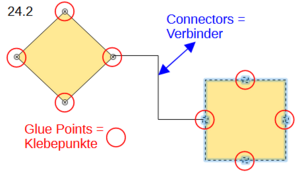
Connectors are lines or arrows whose ends automatically snap to an object's glue point when they are placed there with the mouse.
Connectors are useful when drawing organigrams, flowcharts and mind maps.
When objects are moved or rearranged, the connectors will be fixed to the corresponding glue point.
See "Figure: Example Glue Points with Connector".
Draw offers a number of different connectors with different shapes of endpoints.
Click on the small arrow to the right of the "Connector" icon to view the complete visible "Connectors" toolbar to open.
Drawing geometric shapes
The symbols for drawing geometric shapes are on the Drawing toolbar.
These geometric shapes are explained in the following sections.
A click on the respective small arrow to the right of the icons opens a toolbar that provides access to the tools for the geometric shapes.
Using these tools for geometric shapes is similar to the tool for drawing squares and rectangles.
-
Basic Shapes
-
Symbol Shapes
-
Block Arrows
-
Flowchart
-
Callout Shapes
-
Stars and Banners
-
3D Objects
Default Shapes
Click the small arrow to the right of the Default Shapes icon to open the Default Shapes toolbar for drawing default shapes.
This toolbar also contains a Rectangle and Ellipse tool, identical to those already displayed on the Drawing toolbar.
Symbol Shapes
Click the small arrow to the right of Symbol Shapes to open the Symbol Shapes toolbar and draw with it.
Block arrows
Click the small arrow to the right of the "Block Arrows" icon to open the "Block Arrows" toolbar for block arrows and draw with them.
Flowcharts
Click the small arrow to the right of the Flowcharts icon to open the Flowcharts toolbar and draw with it.
Callouts
Click the small arrow to the right of the Callouts icon to open the Callouts toolbar for drawing callouts.
Stars and Banners
Click the small arrow to the right of the Stars and Banners icon to open the Stars and Banners toolbar for drawing stars and banners.
3D-Objekts
Click the small arrow to the right of the 3D Objects icon to open the 3D Objects toolbar for drawing 3D objects.
Inserting Text
In Draw you can insert and format text.
- As a dynamic text frame, which is an independent drawing object and expands as you add more text within the frame.
- Text within a previously drawn object.
This integrates text within the object and is placed within the bounding box that surrounds an object.
This rectangle is not dynamic and care must be taken to ensure that the text does not lie outside the object boundaries.
See also: Text Boxes in Draw
Insert Images, Fontwork shapes and objects from the Gallery
In Draw you can insert and format images, fontwork shapes and objects from the Gallery as follows:
Images
Images can be inserted using the ▸ menu.
The "Insert Image" dialog opens.
You can now search and select from images stored on your PC.
Select an image and click .
The image is inserted on your active slide (drawing page).
See also: Inserting Images in Draw
Fontwork Shapes

Fontwork shapes can be inserted via the "Standard" toolbar.
Click on the symbol ![]() "Fontwork" and the "Fontwork Gallery" dialog opens.
"Fontwork" and the "Fontwork Gallery" dialog opens.
Select a suitable Fontwork Style and click on it.
Now click on .
This inserts the Fontwork (the text "Fontwork").
While working with Fontwork you will see the toolbar at the bottom "Fontwork" at your disposal.
Now click on the text "Fontwork" and it is highlighted.
Simply write a letter and remove the text you do not need.
Write the text of your choice, here in the example "Mein Text".
Click next to the fontwork and the new text will be displayed as fontwork.
See also: Create and edit Fontwork
Gallery
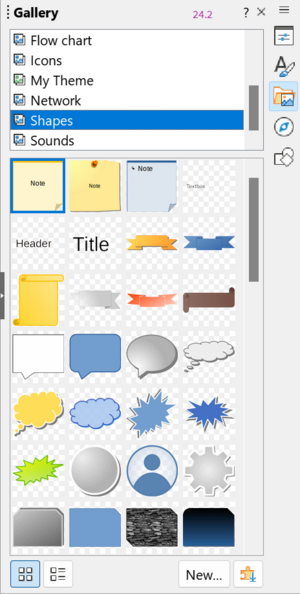
You can also insert elements from the Gallery.
Via the menu choose ▸ , the Sidebar with the objects, which are stored there in several folders.
Select a folder.
Rightclick on the desired object and select .
The object is now inserted.
See also: The Gallery in LibreOffice
Further Informations
Starting with Draw
See: Starting with Draw
Layer functions
Examples shapes - geometry
Areas
Ellipse.odg
Kreis.odg
Parallelogramm.odg
Quadrat.odg
Rechteck.odg
Rechtwinkliges Dreieck - Lehrsatz des Pythagoras.odg
Trapez.odg
Corpus
Kegel.odg
Kugel.odg
Quader.odg
Viereck-Pyramide.odg
Würfel.odg
Zylinder.odg
Documentation / Manuals
Here you will find the Documentation / Manuals:
Any questions?
For questions on this topic go to:
Get Involved
Join us today and help us to make it even better!
Donate
LibreOffice is Free Software and is made available free of charge.
Your donation, which is purely optional, supports our worldwide community.
If you like the software, please consider a Donation.


